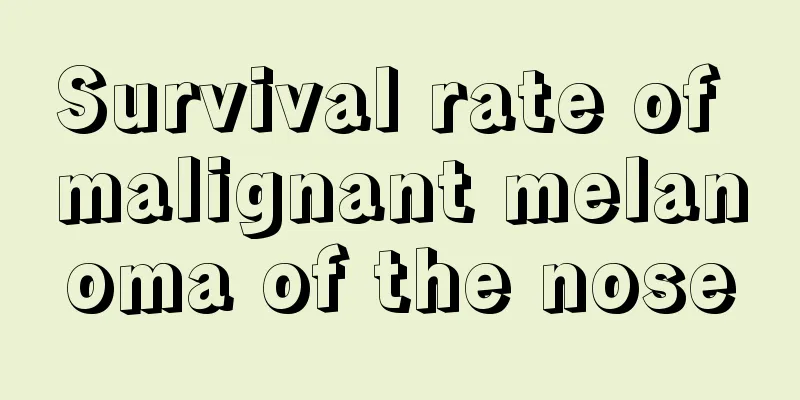Survival rate of malignant melanoma of the nose

|
The survival rate of nasal malignant melanoma is closely related to the stage of the disease, treatment methods and individual differences. Early detection and treatment can significantly improve the survival rate. Nasal malignant melanoma is a rare malignant tumor, and its survival rate is affected by many factors, including tumor size, depth of infiltration, metastasis and the patient's overall health. 1. Disease stage and survival rate The survival rate of nasal malignant melanoma is directly related to the stage of the disease. The 5-year survival rate of patients in early stage I and II is relatively high, about 60%-80%, while the survival rate of patients in late stage III and IV is significantly reduced, especially for patients with distant metastasis, the 5-year survival rate may be less than 20%. Early diagnosis and timely treatment are the key to improving survival rate. 2. Effect of treatment methods on survival rate The choice of treatment directly affects the patient's prognosis. Surgery is the first choice for nasal malignant melanoma, including extensive resection of the tumor and surrounding tissues, and lymph node dissection when necessary. Radiotherapy and chemotherapy can be used as adjuvant treatments, especially for tumors that cannot be completely removed or high-risk patients. In recent years, the application of immunotherapy and targeted therapy has also provided new hope for advanced patients. 3. Individual differences and survival rate The patient's age, immune status, comorbidities, and other factors can also affect survival rates. Young patients with a well-functioning immune system usually have a better prognosis. The patient's psychological state and lifestyle, such as whether they quit smoking and maintain a healthy diet, can also have a certain impact on the treatment effect. 4. Suggestions for improving survival rate Early screening and regular physical examinations are important measures to improve the survival rate of nasal malignant melanoma. For high-risk groups, such as those who are exposed to ultraviolet rays for a long time or have a family history, monitoring should be strengthened. During the treatment process, patients need to actively cooperate in choosing appropriate treatment plans and pay attention to postoperative care and rehabilitation. Although the survival rate of nasal malignant melanoma is affected by many factors, patients still have a chance to obtain a better prognosis through early detection, scientific treatment and good living habits. It is recommended that high-risk groups undergo regular professional examinations and seek medical treatment in time if abnormalities are found, in order to achieve the best treatment effect. |
<<: Is there any hope for colon cancer invading the bladder?
>>: Symptoms of prostate cancer early symptoms
Recommend
Do you feel headache and nausea from using air conditioning?
In the hot summer, many people can’t imagine how ...
Unmarried and childless women may also develop ovarian cancer
Ovarian cancer can occur in women of any age, inc...
The efficacy and function of donkey oil
Simply put, donkey oil is an oily substance extra...
Calories in fresh coconut water
The calories in fresh coconuts are relatively low...
Is laminate flooring harmful to the human body?
Laminate flooring is a material used by many fami...
What are the traditional Chinese medicines for advanced ovarian cancer
Ovarian cancer is one of the common malignant tum...
How long after exercise should you breastfeed during breastfeeding?
During the breastfeeding period, most women need ...
Partially empty sella?
Empty sella is a very common phenomenon in clinic...
Can stomach cancer be cured in the early stage? It is very difficult to cure
It is very difficult to recover from cancer, and ...
What is gastrointestinal stromal tumor
Gastrointestinal stromal tumors refer to a specia...
Is blood in the stool a sign of colon cancer?
Is blood in the stool a sign of colon cancer? Blo...
Does small cell lung cancer cause great harm to patients?
Does small cell lung cancer cause great harm to p...
What are the early symptoms of liver cancer? Eat these four foods to prevent liver cancer
According to statistics, there are 430,000 new ca...
Why is thyroid cancer called the cancer of happiness
Thyroid cancer is called "happy cancer"...
Can a pregnant woman with rectal cancer give birth to a child?
Currently, many women wait until they are very ol...









